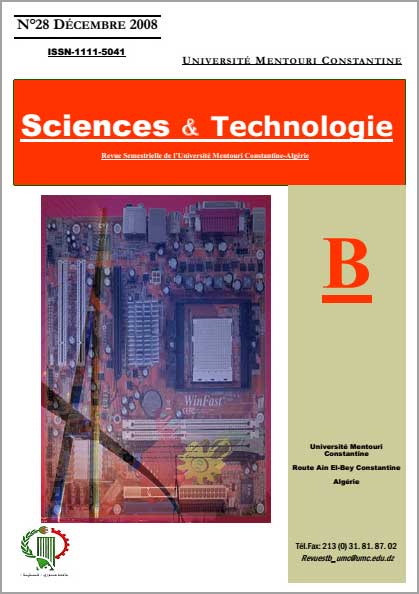MIXED FINITE ELEMENT FOR CRACKED INTERFACE
Mots-clés :
Mixed interface finite element, Cracked interface, Energy release rate, Virtual crack extensionRésumé
A special finite element based on Reissner’s mixed variational principle has been presented to study interfacial cracks in bimaterials. The present element is a 7-node two dimensional mixed finite element with 5 displacement nodes and 2 stress nodes. The mixed interface finite element ensures the continuity of stress and displacement vectors at the interface on the coherent part and the discontinuity of this one on the cracked part. This interface element was associated with the virtual crack extension method to evaluate the energy release rates using only one meshing by finite elements. Results obtained from the present mixed interface element have been shown to be in good agreement with the analytical solutions
Références
S. N. Alturi, S. Gallagher, O. C. Zienkiewicz., ‘Hybrid and
mixed finite element method’, New York, John Willey and
Sons, 1983.
R. C. Mahapatra, S. P. Dasgupta, ‘The mixed finite element
method in elastic and elastoplastic axisymmetric problems’,
Comput. Struct. 30, pp. 1047-1065, 1988.
L. R. Herrmann, ‘A bending analysis for plates’, Proc. Conf.
Matrix Methods in Structural Mechanics, AFFDL-TR-66-80,
pp. 577-604, 1966.
F. A. Mirza, M. D. Olson, ‘The mixed finite element method
in plane elasticity’, Int. J. Num. Meth. Engng. vol. 15, pp.
-289, 1980.
A. K. Noor, ‘Multified (mixed and hybrid) finite elements
models’, State of the art surveys in finite element technology,
ASME, chapter 5, pp. 127-162, 1983.
S. Aivazzadeh, ‘Eléments finis d’interface. Application aux
assemblages collés et structures stratifiées’, Thèse de docteuringénieur,
Université de Technologie de Compiègne, 1984.
M. Habib, ‘Eléments finis axisymétriques d’interface pour
l’analyse des structures stratifiées et des assemblages collés’,
Thèse de doctorat, Université de Claude Bernard (Lyon I),
M. Bichara, ‘Formulation d’éléments d’interface. Application
aux assemblages colles’, Thèse de doctorat, Université Paris
VI, 1990.
A. Sarhan-Bajbouj, ‘Eléments finis d’interface pour le calcul
des structures hétérogènes’, Thèse de doctorat, Université de
Claude Bernard (Lyon I), 1990.
C. P. Wu, C. C. Lin, ‘Analysis of sandwich plates using
mixed finite element’, Compos. Strut. 25, pp. 397-405, 1993.
E. Carrera, ‘C0 Reissner-Mindlin multilayered plate elements
including zig-zag and interlaminar stress continuity’, Int. J.
Num. Meth. Engng. 39, pp. 1797-1820, 1996.
E. Carrera, ‘Mixed layer-wise models for multilayered plates
analysis’, Compos. Struct. 43, pp. 57-70, 1998.
E. Carrera, ‘Transverse normal stress effects in multilayered
plates’, ASME J. Appl. Mech., 66, pp. 1004-1011, 1999.
G. S. Ramtekkar, Y. M. Desai, A. H. Shah, ‘Mixed finite
element model for thick composite laminated plates’, Mech.
Adv. Mater. Struct. 9, pp. 133-156, 2002.
G. S. Ramtekkar, Y. M. Desai, A. H. Shah, ‘Application of
three-dimensional mixed finite element model to the flexure of
sandwich plate’, Comput. Struct. 81, pp. 2183-2198, 2003.
Y. M. Desai, G. Y. Ramtekkar, ‘Mixed finite element model
for laminated composite beams’, Struct. Eng. Mech. 13, pp.
-276, 2002.
A. N. Bambole, Y. M. Desai, ‘Hybrid-interface finite element
for laminated composite and sandwich beams’, Finite
Elements in Analysis and Design, 43, pp. 1023-1036, 2007.
H. Bouzerd, ‘Elément fini mixte pour interface cohérente ou
fissurée’, Thèse de doctorat, Université de Claude Bernard
(Lyon I), 1992.
G. Verchery, ‘Méthodes numériques de calcul des champs de
contraintes dans les matériaux hétérogènes, Calcul des
Structures et Intelligence Artificielle’, Fouet J. M., Ladeveze
P., Ohayon R., vol. 1, Paris, Pluralis, pp. 7-21, 1987.
R. H. Gallagher, ‘Introduction aux éléments finis’, Pluralis
(traduction française), 1976.
D. M. Parks, ‘A stiffness derivative finite element technique
for determination of elastic crack tip stress intensity factors’,
Int. J. Fracture, 10, pp. 487-502, 1974.
N. J. Pagano, ‘Exact solutions for rectangular bidimensionnal
composite and sandwich plates’, Journal of Composite
Materials, vol. 4, pp. 20-35, 1970.
K. Y. Lin and J. W. Mar, ‘Finite element analysis of stress
intensity for cracks at a bimaterial’, Int. Journal of Fracture,
vol. 12, pp. 521-531, 1976.
J. R. Rice and G. C. Sih, ‘Plane problems of cracks in
dissimilar media’, Journal of Appl. Mech., 32 series E, n°2,
pp. 418-423, 1965.
Téléchargements
Publié-e
Comment citer
Numéro
Rubrique
Licence
Les auteurs publiant dans cette revue acceptent les termes suivants :- Les auteurs détiennent le droit d'auteurs et accordent à la revue
le droit de première publication, avec l’ouvrage disponible simultanément [SPÉCIFIER LA PÉRIODE DE TEMPS] après publication, sous la licence Licence d’attribution Creative Commons qui permet à d'autres de partager l'ouvrage en en reconnaissant la paternité et la publication initiale dans cette revue. - Les auteurs peuvent conclure des ententes contractuelles additionnelles et séparées pour la diffusion non exclusive de la version imprimée de l'ouvrage par la revue (par ex., le dépôt institutionnel ou la publication dans un livre), accompagné d'une mention reconnaissant sa publication initiale dans cette revue.
- Les auteurs ont le droit et sont encouragés à publier leur ouvrage en ligne (par ex., dans un dépôt institutionnel ou sur le site Web d'une institution) avant et pendant le processus de soumission, car cela peut mener à des échanges fructueux ainsi qu'à un nombre plus important, plus rapidement, de références à l’ouvrage publié (Consulter The Effect of Open Access).

